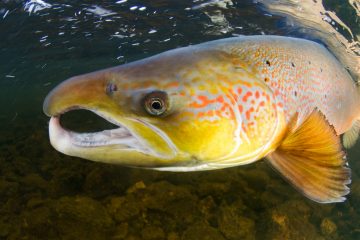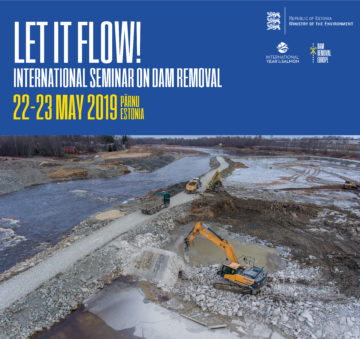The removal of the Sindi Dam and other barriers along Estonia’s Pärnu River will mean more than 3000 kilometres of waterway can flow unrestricted once again. By allowing salmon and other fish species to migrate naturally, this will breathe new life into the river basin and local economies. Estonia’s pioneering efforts will be showcased during a Dam Removal Europe seminar on May 22 and 23, 2019.

Record-breaking removal
As a leading example of river restoration for the whole of Europe, the removal of a huge dam on Estonia’s Pärnu River in Estonia will soon bring wide-ranging benefits to both wild nature and numerous Estonian communities. The removal of the 150-metre wide, 4.5-metre high Sindi Dam, together with a series of smaller dams upriver, will mean more than 3000 kilometres of waterway can flow freely, enabling salmon and other fish to follow their natural migration routes once again.
When they visit the site of the dam on May 23, participants in an Estonia-based Dam Removal Europe seminar will be viewing the largest river restoration project in Europe to date.

“Together with its 270 tributaries, the Pärnu was traditionally the biggest salmon river in Estonia,” explains Külli Tammur of Estonia’s Environment Agency, who led the restoration work. “It was a huge challenge, but now the work is almost done, we are very proud.”
Direct impact
Across its basin the Pärnu River drains an estimated one-fifth of Estonia, which means restoration efforts could have a huge impact on the country’s salmon population.
“Estonia will benefit from the dam removal directly,” says Tammur. “We estimated that the annual ‘cost’ of the dam in terms of its impact on nature was about 4 million euros. Fish will soon be able to swim upriver about 100 kilometres, supporting wild nature and benefitting people through angling and other nature-based tourism opportunities.”
Stunning example
Removing the Sindi Dam, and a series of 10 smaller dams upriver, is expected to cost around 15 million euros. Most of the funding will come from the EU, with the remainder made up by the Estonian government. The privately owned Sindi Dam, which was built in 1975 to help provide water for the local (now disappeared) wool industry, had been obsolete for many years.
Demolition of the dam began on October 2018, following a long consultation period with local communities. While an artificial lake behind the dam has been lost, the river will be made deeper in stretches to enable swimming, riverbank pathways will be created, a rapid left in place for kayakers, and recreational fishing will be legalised.
Arjan Berkhuysen, Managing Director of the World Fish Migration Foundation, believes the deconstruction of the Sindi Dam is a stunning example of dam removal and river restoration best practice.
“Local communities have been involved every step of the way, which is one of the main reasons why there has been so much public support,” he says. “Estonia should be applauded for its efforts, which close monitoring of the river should soon prove transformative in many ways.”
Location of the Sindi dam in Parnu river.
Dam removal momentum
Hundreds of thousands of dams and other barriers, most small and many obsolete, fragment Europe’s rivers. These structures, some of them hundreds of years old, have provided irrigation, energy and other benefits. But their presence has a seriously detrimental impact on fish and other wildlife. With wild nature along European rivers in long-term decline, the removal of dams has proven to be the most environmentally efficient and cost-effective measure for river restoration.
Dam removal gained momentum in Europe after the EU adopted the Water Framework Directive in 2000, which requires member states to improve the ecological protection of rivers and lakes. While some European countries – most notably those on the Balkan Peninsula– are currently on a dam-building spree, dam deconstruction is now ramping up in many others. The past two decades have seen at least 5,000 small dams, weirs and culverts removed from rivers in France, Sweden, Finland, Spain and the United Kingdom.
Speed up the process
Across all of Rewilding Europe’s operational areas we are working to create space for self-governing natural processes to shape ecosystems. In addition to letting processes such as forest regeneration, flooding and natural grazing impact landscapes, this also involves restoring rivers to their free-flowing state, or as close to this state as we can achieve.
“Living rivers are essential for healthy European landscapes and the removal of dams is often the most effective way to achieve this,” says Rewilding Europe’s Wouter Helmer, who will attend the Dam Removal Europe (DRE) seminar in May. “At Rewilding Europe we are currently exploring scalable financial models that could speed up the proces of removing obsolete dams.”
In 2018, Rewilding Europe conducted river restoration in two of its operational areas: Swedish Lapland and the Oder Delta. This work included the removal of log dams that are a legacy of the forestry industry (in Swedish Lapland), as well as the creation of spawning grounds (in both areas). Rewilding Europe is also involved in the upcoming removal of dams on the Kagach and Kagilnyk Rivers in the Ukrainian Danube Delta.
 Rewilding Europe joined Dam Removal Europe– a European-wide coalition of organisations – in 2018. Together with WWF, the World Fish Migration Foundation, The Rivers Trust and ERN France, we will continue our efforts to scale up Europe’s dam removal process. A process which – as the removal of the Sindi Dam will surely demonstrate – can bring huge benefits to both man and wild nature.
Rewilding Europe joined Dam Removal Europe– a European-wide coalition of organisations – in 2018. Together with WWF, the World Fish Migration Foundation, The Rivers Trust and ERN France, we will continue our efforts to scale up Europe’s dam removal process. A process which – as the removal of the Sindi Dam will surely demonstrate – can bring huge benefits to both man and wild nature.
More about dam removal
- View a video of the Sindi Dam Removal on YouTube.
- River restoration in Swedish Lapland.
- Small river restoration in the Oder Delta.
- River restoration in the Ukrainian Danube Delta.
